Laparoscopic Retrieval Bags Market Size and Share
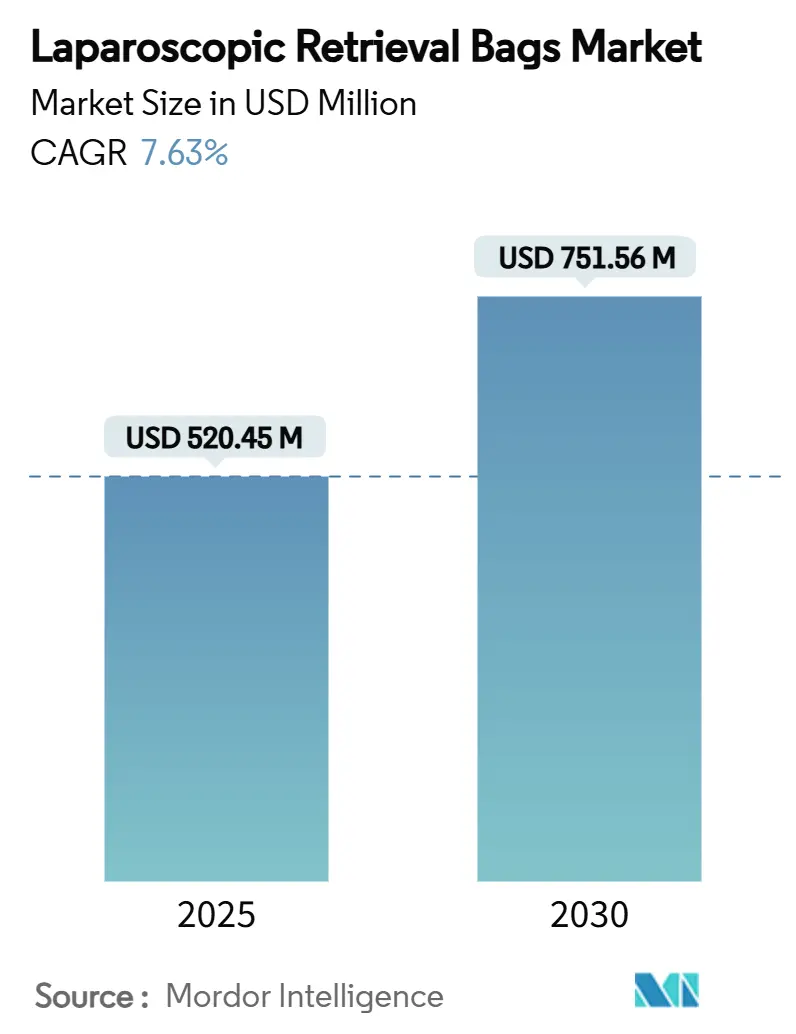
Laparoscopic Retrieval Bags Market Analysis by Mordor Intelligence
The laparoscopic retrieval bags market size stands at USD 520.45 million in 2025 and is forecast to advance at a 7.63% CAGR to reach USD 751.56 million by 2030. Robust uptake of minimally invasive surgery, regulatory preferences for single-use sterile consumables, and steady product innovation in self-opening mechanisms collectively underpin this expansion. Detachable bag designs, compatibility with robotic platforms, and rising volumes of day-case laparoscopic procedures are widening procurement opportunities for vendors. Hospitals continue to anchor demand, yet ambulatory surgical centres (ASCs) are reshaping purchasing criteria by favouring cost-efficient, disposable kits. Regionally, North America retains leadership on the back of established reimbursement for advanced laparoscopy, while Asia-Pacific registers the briskest growth in step with large-scale infrastructure upgrades.
Key Report Takeaways
- By type, detachable systems captured 57.78% of laparoscopic retrieval bags market share in 2024, whereas the same segment is projected to expand at an 8.23% CAGR through 2030.
- By technique, manual opening commanded 62.45% of the laparoscopic retrieval bags market size in 2024, while automatic opening systems hold the highest forecast CAGR at 8.28% to 2030.
- By application, gastrointestinal surgery accounted for 39.93% share of the laparoscopic retrieval bags market size in 2024 and urology is advancing at an 8.34% CAGR through 2030.
- By end user, hospitals held 67.78% revenue share in 2024, yet ASCs record the quickest CAGR at 8.39% across the forecast span.
- By geography, North America commanded 41.21% share of the laparoscopic retrieval bags market size in 2024, while Asia-Pacific exhibits an 8.43% CAGR to 2030.
Global Laparoscopic Retrieval Bags Market Trends and Insights
Drivers Impact Analysis
| Driver | (~) % Impact on CAGR Forecast | Geographic Relevance | Impact Timeline |
|---|---|---|---|
| Rising demand for minimally-invasive surgery | +2.1% | Global with strongest effect in North America and Europe | Medium term (2-4 years) |
| Growing burden of target abdominal and pelvic diseases | +1.8% | Global, especially Asia-Pacific and Middle East & Africa | Long term (≥ 4 years) |
| Expansion of ambulatory surgery centres worldwide | +1.2% | North America and Europe core, expanding to Asia-Pacific | Medium term (2-4 years) |
| Technological advances in self-opening bag mechanisms | +0.9% | Global, led by United States, Germany and Japan | Short term (≤ 2 years) |
| Surge in regulations favouring single-use sterile devices | +0.6% | Europe and North America, spreading to Asia-Pacific | Medium term (2-4 years) |
| Development of biodegradable polymer retrieval bags | +0.4% | Global with early adoption in sustainability-focused markets | Long term (≥ 4 years) |
| Source: Mordor Intelligence | |||
Rising Demand for Minimally-Invasive Surgery
Minimally invasive techniques now represent more than 80% of select surgical categories in leading health systems, shortening length of stay by up to 3 days and lowering complication risk. New imaging platforms such as the EVIS X1 endoscopy system cleared by the FDA in 2025 have raised image quality standards, reinforcing surgeon confidence in laparoscopy [1]Olympus America, “EVIS X1 Endoscopy Platform Receives FDA Clearance,” olympusamerica.com. Training curricula increasingly centre on advanced laparoscopic skills, creating a workforce predisposed to prefer these methods. Each minimally invasive case typically necessitates a sterile extraction bag, which directly lifts unit consumption. In value-based payment environments, faster recovery and fewer infections underpin further procedure migration to laparoscopy, accelerating demand across the laparoscopic retrieval bags market.
Growing Burden of Target Abdominal & Pelvic Diseases
Colorectal cancer interventions have climbed by 15% year on year in developed economies, while gallbladder, appendiceal, and gynaecological cases add to the cumulative surgical volume. In Japan alone, the medical device sector reached USD 40 billion in 2021 and is tracking a 5.5% CAGR to 2027, signalling substantial procedure throughput growth [2]U.S. Department of Commerce, “Japan Medical Device Market,” commerce.gov. Rising obesity and diabetes rates contribute to metabolic and urological surgeries that also rely on specimen retrieval during laparoscopy. Asia-Pacific records the steepest epidemiological transition, compelling hospitals to expand theatre capacity and stock greater quantities of single-use retrieval consumables to avoid sterilisation bottlenecks.
Expansion of Ambulatory Surgery Centres Worldwide
ASC procedure throughput is forecast to surge 21%, touching 44 million cases by 2034 as payers embrace same-day discharge protocols. Their lean business model favours disposable kits free of reprocessing overhead, prompting vendors to recalibrate product lines toward low-cost, ready-to-use retrieval bags. Medicare’s widening reimbursement list for complex laparoscopic work further cements the outpatient trend. Suburban patient bases and transparent pricing strengthen ASC competitiveness, inserting new volume into the laparoscopic retrieval bags market and reshaping distribution patterns toward group purchasing entities serving ASC chains.
Technological Advances in Self-Opening Bag Mechanisms
Patent filings highlight vigorous R&D around spring-loaded, shape-memory and magnetic deployment systems that guarantee full bag opening irrespective of trocar angulation. Robotic platforms such as da Vinci 5 now integrate force-feedback, pushing suppliers to design bags that can synchronise with haptic signals. Olympus earned a 2024 patent on flexible inner shafts that embed cutting elements into detachable bag assemblies, underscoring the shift toward multifunctional retrieval solutions. Reliable automatic opening reduces dwell time inside the abdominal cavity, appealing to surgeons aiming to standardise outcomes and shorten anaesthesia exposure.
Restraints Impact Analysis
| Restraint | (~) % Impact on CAGR Forecast | Geographic Relevance | Impact Timeline |
|---|---|---|---|
| High average selling price of premium retrieval bags | -1.2% | Global, strongest in price-sensitive emerging markets | Short term (≤ 2 years) |
| Availability of alternative specimen-removal techniques | -0.8% | Global, higher in cost-constrained systems | Medium term (2-4 years) |
| Environmental scrutiny over single-use plastics in ORs | -0.6% | Europe and North America, moving to wider markets | Medium term (2-4 years) |
| Limited compatibility with next-gen robotic trocars | -0.4% | North America and Europe where robotic use is high | Short term (≤ 2 years) |
| Source: Mordor Intelligence | |||
High Average Selling Price of Premium Retrieval Bags
Automatic deployment features command 40-60% price premiums compared with manual bags, sparking push-back from procurement teams running cost-containment initiatives. Value-based contracts obligate vendors to furnish outcome evidence that offsets incremental spend, damping discretionary upgrades. Competitive pricing from Asian manufacturers tightens margins, while hospital formularies standardise on a narrow band of lower-cost SKUs to exploit volume discounts. This environment may temper the premium segment within the laparoscopic retrieval bags market until proven clinical advantages outweigh cost concerns.
Environmental Scrutiny Over Single-Use Plastics in ORs
Hospital sustainability committees are quantifying waste, spotlighting consumables like retrieval bags. Emerging EU packaging directives and electronic IFU requirements introduce compliance expenses for device makers [3]Emergo by UL, “EU Packaging and IFU Rules Tighten,” emergobyul.com . Although biodegradable polymers offer promising disposal benefits, regulators impose stringent biocompatibility tests that lengthen approval cycles. Health systems increasingly set waste-reduction targets, nudging purchasing departments toward vendors that commit to recycling or bio-safe materials. This adds CAPEX for R&D and may slow adoption unless performance parity with proven plastics is demonstrated.
Segment Analysis
By Type: Detachable Designs Drive Market Leadership
Detachable designs captured 57.78% of laparoscopic retrieval bags market share in 2024, reflecting surgeon preference for specimen handling flexibility and compatibility with robot-assisted arms. This segment is forecast to post an 8.23% CAGR through 2030, outpacing the broader laparoscopic retrieval bags market. Innovation concentrates on secure fastening interfaces that withstand torque during extraction while enabling rapid separation once the bag reaches the umbilical port. Firms investing in robust latch geometries and radio-opaque markers facilitate fluoroscopic confirmation of complete removal, a feature valued in bariatric and oncological surgeries. Non-detachable bags occupy steady niches such as routine cholecystectomy where streamlined instrument counts matter more than modularity.
Continued miniaturisation of robotic wrists magnifies demand for slimline detachable bags that traverse 5 mm trocars without compromising specimen volume. Olympus’s flexible inner shaft technology exemplifies how detachable sub-components can incorporate active cutting or cautery, enhancing procedural efficiency while keeping bag integrity intact. As hospitals standardise on robotic theatres, the detachable cohort is expected to widen its contribution to the laparoscopic retrieval bags market size.
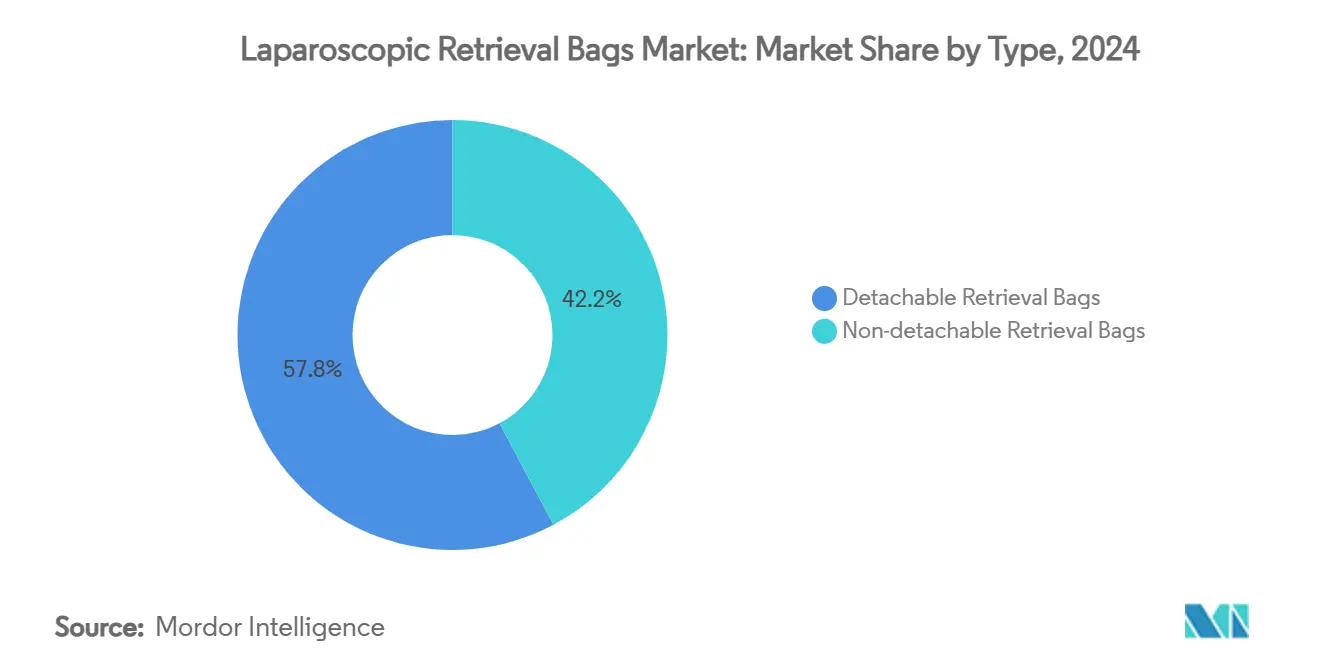
By Technique: Manual Opening Maintains Dominance Despite Automation Trends
Manual bags retained 62.45% of the laparoscopic retrieval bags market size in 2024 because of their familiar deployment and economical pricing, yet automatic formats post the sharpest growth at 8.28% CAGR. Manual devices benefit from simple mechanics and lower failure risk, making them the default in high-volume gallbladder or appendectomy programmes. Training curricula also reinforce comfort with traditional pull-string openings, sustaining share.
Automatic bags answer workflow variability concerns, particularly in robot-assisted suites where the surgeon operates from a console distant from the sterile field. Spring-triggered or SMA-driven rims guarantee mouth opening even at awkward angles, reducing need for ancillary grasper manipulation. Although higher cost deters deployment in budget-sensitive settings, university hospitals piloting standardised robotic pathways increasingly stipulate automatic bags for consistency. Patent activity from Boston Scientific on novel seal assemblies illustrates the competitive importance of reliability in auto-open categories. Broader availability of low-priced auto-open SKUs is expected to tilt incremental demand toward the segment over the forecast horizon.
By Application: Gastrointestinal Procedures Lead While Urology Accelerates
Gastrointestinal surgeries represented 39.93% of total consumption in 2024, securing their position as the largest application by virtue of high cholecystectomy and colorectal volumes. The segment’s entrenched laparoscopy protocols keep it a pillar of vendor sales pipelines. Hospitals purchase multiple bag sizes to accommodate variable specimen mass ranging from gallstones to partial colectomy samples, reinforcing repeat-purchase cycles within the laparoscopic retrieval bags market.
Urology, posting an 8.34% CAGR, overtakes competing specialties in growth velocity as prostatectomies and nephrolithotomies migrate to minimally invasive pathways. Reduced port diameters and delicate tissue handling requirements trigger the need for thin-film, puncture-resistant bags. Suppliers that tailor mouth diameters and deploy ease for confined pelvic spaces gain traction with urological surgeons. Focus on rapid stone extraction stimulates design tweaks such as reinforced seams and graduated capacity indicators that promote safe over-loading thresholds. Close collaboration between device engineers and urologists is therefore pivotal to sustain momentum in this high-growth niche.
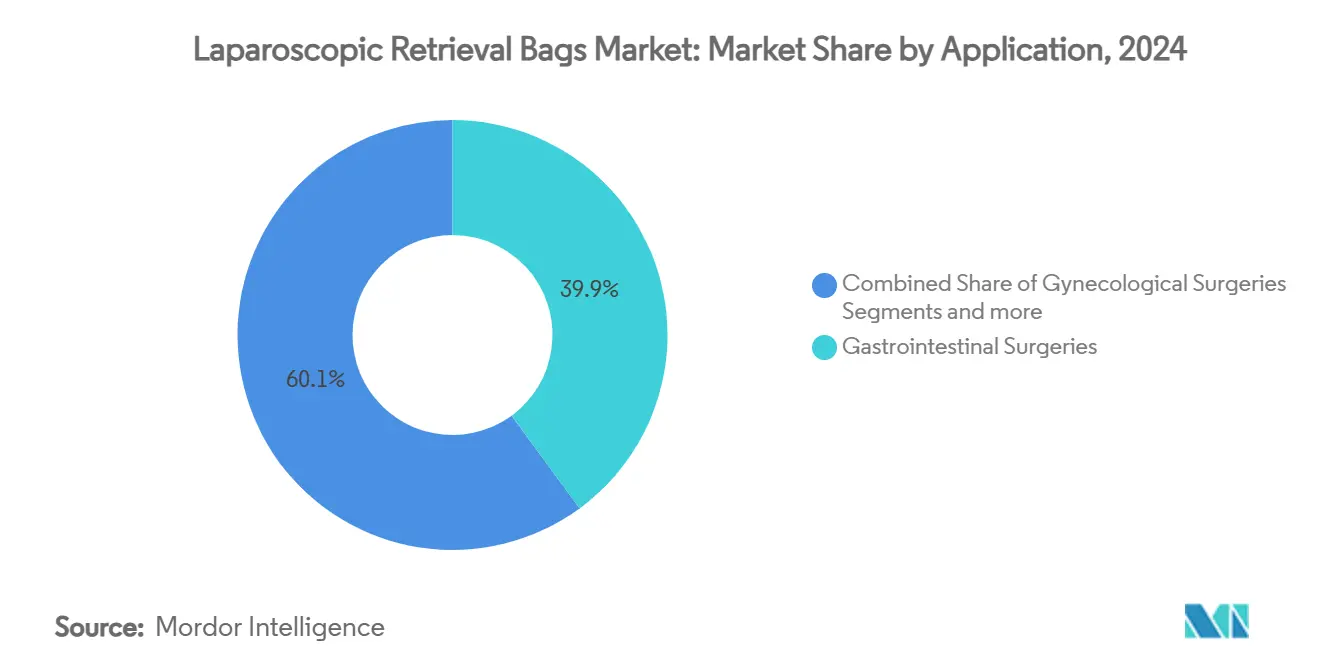
Note: Segment shares of all individual segments available upon report purchase
By End User: Hospital Dominance Faces ASC Challenge
Hospitals generated 67.78% of total revenue in 2024 because complex oncological and bariatric procedures remain centralised in tertiary centres that possess full critical-care back-up. Integrated purchasing departments favour bundled device portfolios, allowing multinationals such as Johnson & Johnson to cross-sell retrieval bags alongside trocars and staplers. Research collaborations and clinical trial pipelines also bias hospitals toward premium auto-open devices that support protocol consistency.
ASCs, however, are projected to outpace with an 8.39% CAGR as same-day laparoscopy becomes mainstream. These centres prize consistent per-case cost and minimal reprocessing downtime, driving preference for single-use retrieval kits packaged with ancillary tools. The anticipated rise to 44 million ASC procedures by 2034 opens a fertile channel for mid-tier manufacturers able to supply quality-to-price optimised offerings. Suppliers investing in compact, all-inclusive sterile bags that shrink setup time align squarely with ASC workflow priorities.
Geography Analysis
North America posted 41.21% of global revenue in 2024, underpinned by high adoption of robotic-assisted surgery and favourable reimbursement that offsets premium consumable costs. FDA clarity on single-use device pathways accelerates time to market, and institutional review boards often require sterile retrieval for specimen integrity, supporting predictable purchasing volumes. Cross-selling across extensive device portfolios grants established vendors stable contracting leverage with group purchasing organisations.
Asia-Pacific leads growth at an 8.43% CAGR thanks to aggressive capital expenditure on surgical infrastructure in China, India and Japan. The Japanese medical device market’s 5.5% CAGR through 2027 reflects a demographic imperative for gastrointestinal and urological procedures among ageing citizens. China’s climb toward a USD 210 billion device market by 2025 continues to open quota opportunities for international brands that localise production. India’s updated medical device ethical marketing code encourages transparency, smoothing import approvals and catalysing adoption of high-quality retrieval consumables. Public–private partnership hospitals in tier-2 cities present untapped volume pockets, further enlarging the laparoscopic retrieval bags market.
Europe shows moderate expansion driven by stringent MDR compliance that rewards quality and safety. Sustainability goals spur trials of biodegradable polymers, creating a differentiating avenue for innovators. Fragmented reimbursement across member states pressures vendors to present clear health-economic data, but consistent clinical guidelines on minimally invasive cancer surgery preserve baseline demand. Middle East, Africa and South America combine emerging private hospital chains and government modernisation schemes to supply long-run upside, though currency volatility and procurement bureaucracy can temper near-term shipments.
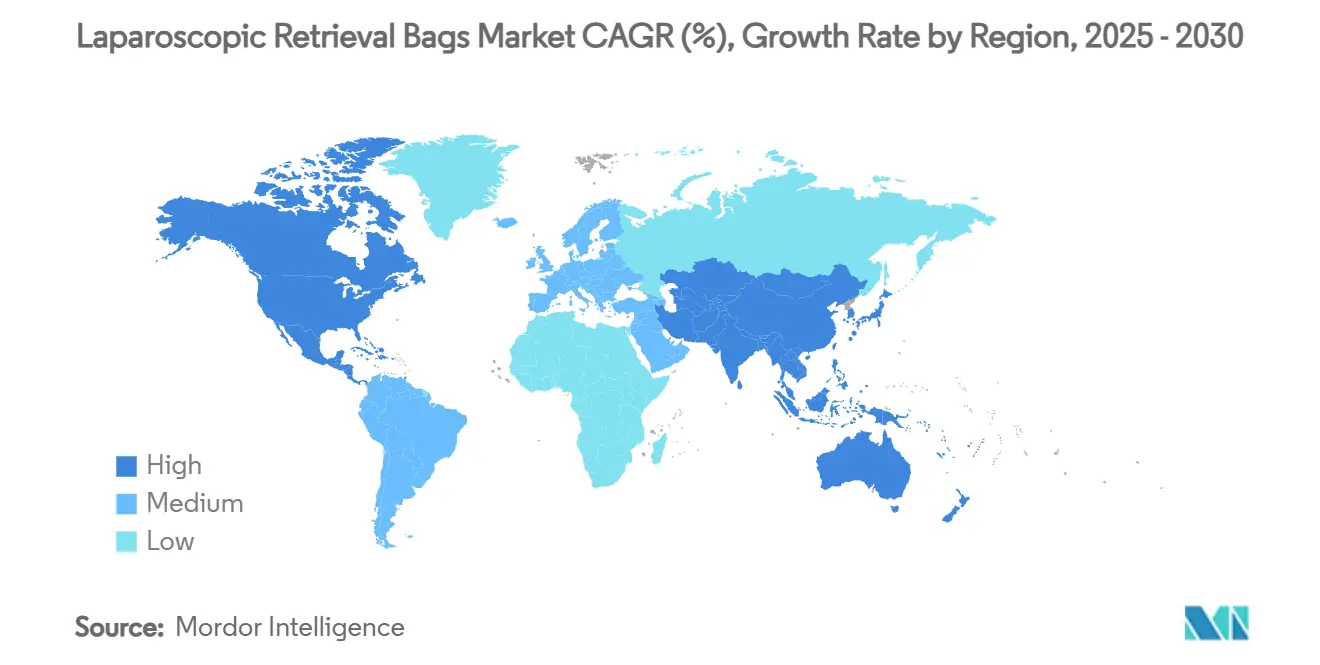
Competitive Landscape
The field remains moderately fragmented. Ethicon and Medtronic maintain strong share via expansive laparoscopic portfolios and entrenched relationships with IDNs and academic centres. Their ability to bundle scopes, trocars and staplers with retrieval bags shortens tender cycles and stabilises margins. Mid-sized players concentrate on differentiated features such as bioresorbable films or ultra-low-profile hoods tailored for single-incision surgery.
Intellectual property jockeying intensifies around deployment reliability, antimicrobial coatings and eco-friendly materials. Boston Scientific’s patent on medical seal assemblies that integrate controlled film release positions the firm to venture deeper into specimen extraction accessories. Start-ups emphasise compostable polymers and carbon-neutral manufacturing, seeking early-adopter hospitals pursuing ESG targets. Meanwhile, global players pilot recycling schemes that offset sustainability objections while protecting the single-use business model, exemplified by Ethicon’s 2025 take-back programme.
Strategic M&A continues: Medtronic’s USD 850 million purchase of Fortimedix Surgical in 2024 bolstered its minimally invasive platform with complementary energy devices that pair well with retrieval products. Partnerships with robotic firms also shape competitive dynamics, as compatibility certification can lock in consumable sales over multi-year service contracts. Overall, competition hinges on marrying clinical efficacy, cost-effectiveness and sustainability to win formulary placement.
Laparoscopic Retrieval Bags Industry Leaders
-
Johnson & Johnson
-
Medtronic
-
Richard Wolf GmbH
-
Vernacare
-
Purple Surgical
- *Disclaimer: Major Players sorted in no particular order
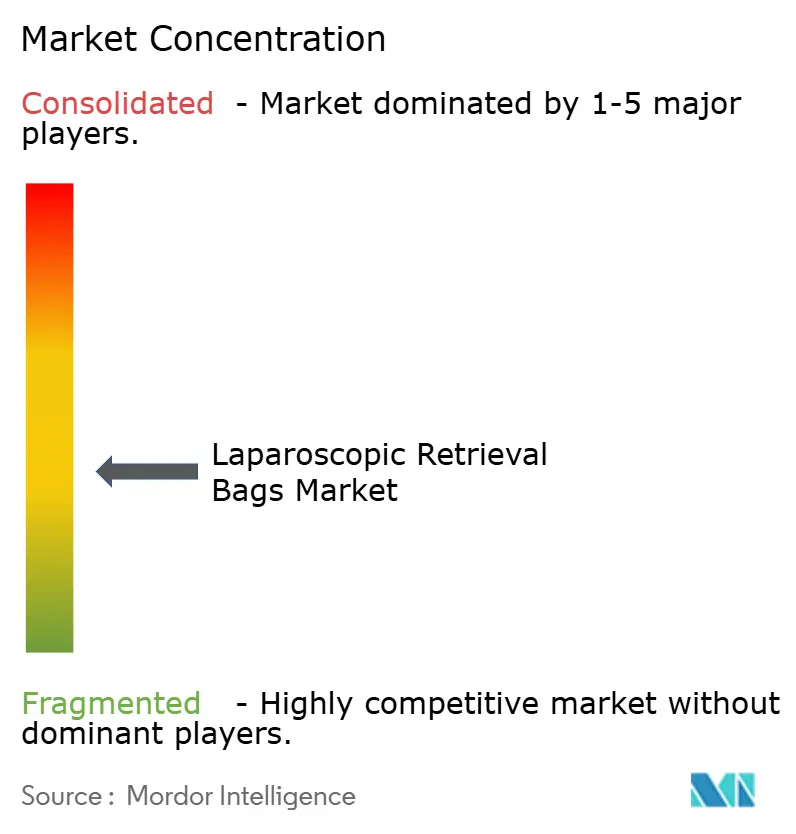
Recent Industry Developments
- May 2025: Olympus Corporation secured FDA clearance for its EZ1500 endoscopes featuring Extended Depth of Field technology, a move that enhances lesion visualisation and supports broader laparoscopic uptake.
- March 2025: Johnson & Johnson’s Ethicon division extended its surgical-instrument recycling programme, answering sustainability drivers while maintaining focus on sterile single-use retrieval solutions.
- December 2024: Surgsci Medical Ltd. launched disposable laparoscopic specimen bags in multiple capacities to service general, urology, and gynaecology theatres.
- November 2024: Medtronic closed an USD 850 million acquisition of Fortimedix Surgical, expanding its energy device line that complements retrieval bag workflows.
Global Laparoscopic Retrieval Bags Market Report Scope
Laparoscopic retrieval bags are used to collect specimens such as adnexal cysts, benign cysts, and other tissue masses while avoiding spillage and contamination to other organs. The Laparoscopic Retrieval Bags Market is segmented by Type (Detachable Retrieval Bags, Non-detachable Retrieval Bags), Technique (Manual Opening and Automatic Opening), Application (Gastrointestinal Surgeries, Gynecological Surgeries, Urological Surgeries, and Other Applications), and Geography (North America, Europe, Asia-Pacific, and Rest of World). The market report also covers the estimated market sizes and trends for 17 different countries across major regions globally. The report offers the value (in USD million) for the above segments.
| Detachable Retrieval Bags |
| Non-detachable Retrieval Bags |
| Manual Opening |
| Automatic Opening |
| Gastrointestinal Surgeries |
| Gynecological Surgeries |
| Urological Surgeries |
| Other Applications |
| Hospitals |
| Ambulatory Surgical Centres |
| Specialty Clinics |
| Others |
| North America | United States |
| Canada | |
| Mexico | |
| Europe | Germany |
| United Kingdom | |
| France | |
| Italy | |
| Spain | |
| Rest of Europe | |
| Asia-Pacific | China |
| Japan | |
| India | |
| Australia | |
| South Korea | |
| Rest of Asia-Pacific | |
| Middle East and Africa | GCC |
| South Africa | |
| Rest of Middle East and Africa | |
| South America | Brazil |
| Argentina | |
| Rest of South America |
| By Type | Detachable Retrieval Bags | |
| Non-detachable Retrieval Bags | ||
| By Technique | Manual Opening | |
| Automatic Opening | ||
| By Application | Gastrointestinal Surgeries | |
| Gynecological Surgeries | ||
| Urological Surgeries | ||
| Other Applications | ||
| By End User | Hospitals | |
| Ambulatory Surgical Centres | ||
| Specialty Clinics | ||
| Others | ||
| By Geography | North America | United States |
| Canada | ||
| Mexico | ||
| Europe | Germany | |
| United Kingdom | ||
| France | ||
| Italy | ||
| Spain | ||
| Rest of Europe | ||
| Asia-Pacific | China | |
| Japan | ||
| India | ||
| Australia | ||
| South Korea | ||
| Rest of Asia-Pacific | ||
| Middle East and Africa | GCC | |
| South Africa | ||
| Rest of Middle East and Africa | ||
| South America | Brazil | |
| Argentina | ||
| Rest of South America | ||
Key Questions Answered in the Report
What is the current value of the laparoscopic retrieval bags market?
The laparoscopic retrieval bags market size is USD 520.45 million in 2025 and is projected to reach USD 751.56 million by 2030.
Which segment grows fastest within retrieval bag techniques?
Automatic opening systems register the highest CAGR at 8.28% through 2030 owing to robotic surgery integration.
Why are detachable retrieval bags preferred by surgeons?
Detachable designs allow independent specimen manipulation, reduce extraction torque and align well with robot-assisted workflows.
Which region shows the strongest growth outlook?
Asia-Pacific posts the fastest regional CAGR at 8.43% driven by healthcare infrastructure expansion in China, India and Japan.
How do ambulatory surgery centres influence demand?
ASCs favour single-use, cost-efficient retrieval kits, propelling an 8.39% CAGR in this end-user segment as day-case laparoscopy rises.
What sustainability actions are key suppliers taking?
Leading companies are piloting recycling programmes and researching biodegradable polymers to address environmental scrutiny over single-use plastics.
Page last updated on:



